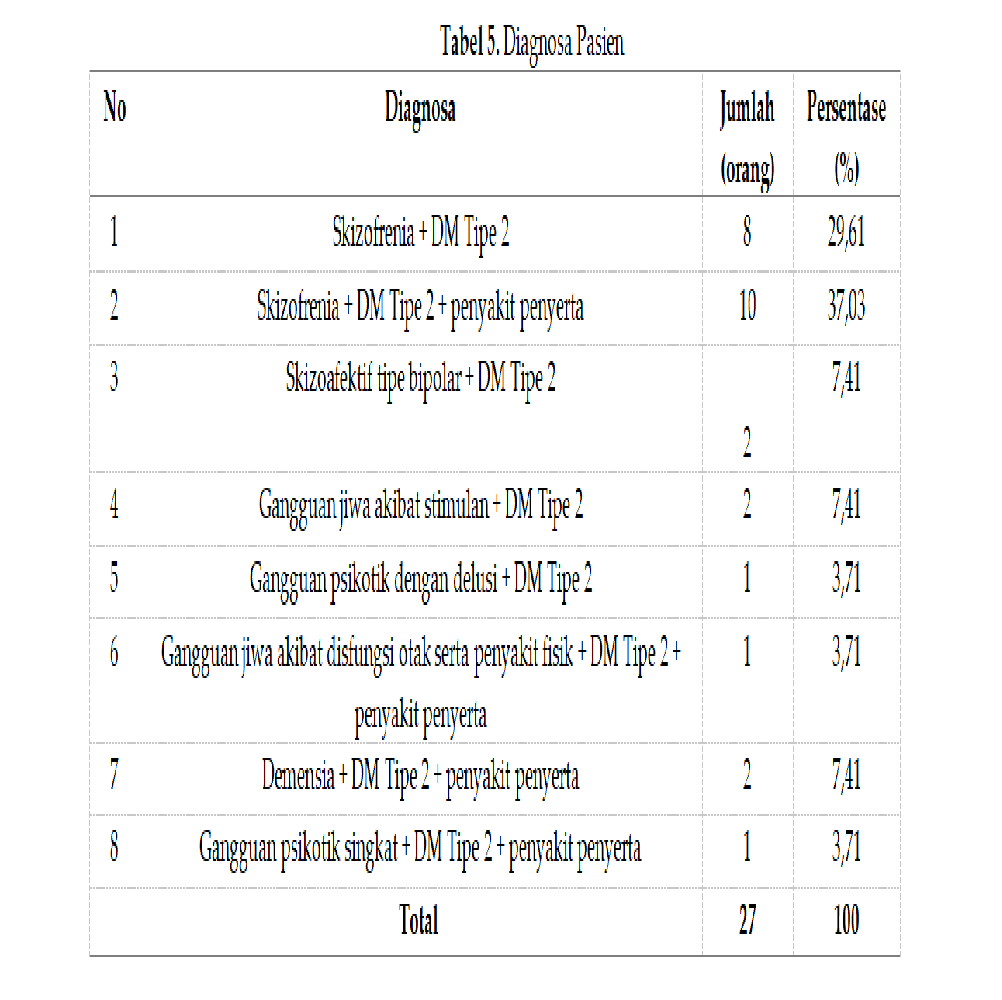Main Article Content
Abstract
Keywords
Article Details

This work is licensed under a Creative Commons Attribution 4.0 International License.
References
- Abdulah, Afry Zaldy, Titik Suerni, and Etik Nurochmah. 2023. “Masalah Kesehatan Mental Generasi Z Di Rumah Sakit Jiwa.” Jurnal Keperawatan Jiwa (JKJ): Persatuan Perawat Nasional Indonesia 11(2): 267–72.
- Aulia Ramdini, Dwi, Lilik Koernia Wahidah, and Dwi Atika. 2021. “Evaluasi Rasionalitas Penggunaan Obat Diabetes Melitus Tipe Ii Pada Pasien Rawat Jalan Di Puskesmas Pasir Sakti Tahun 2019.” JFL: Jurnal Farmasi Lampung 9(1): 69–76.
- Ernst, E. 2001. “Drug Interactions. A Source Book of Adverse Interactions, Their Mechanisms, Clinical Importance and Management.” Focus on Alternative and Complementary Therapies 6(1): 49–49.
- Haerani. 2021. “Evaluasi Rasionalitas Penggunaan Obat Antihipertensi Pada Pasien Geriatri Di Instalasi Rawat Inap Rs Islam Siti Khadijah Kota.” 4(2): 134.
- Hidayat, Arief Nur, Tiara Ajeng L, and Kusumaningtyas Siwi. 2023. “EVALUASI RASIONALITAS OBAT ANTIDIABETES ORAL TERHADAP EFEKTIVITAS TERAPI PASIEN DIABETES MELITUS TIPE II RSUD Dr. MOEWARDI SURAKARTA.” Jambura Journal of Health Sciences and Research 5(3): 815–24.
- Kemenkes RI. 2011. “Modul Penggunaan Obat Rasional 2011.” Modul Penggunaan Obat Rasional: 3–4.
- Lestari. 2019. “Implementasi Metode Clark Dan Young Untuk Menentukan Dosis Obat Pada Anak-Anak.” Angewandte Chemie International Edition, 6(11), 951–952. 2(1): 100–108.
- Pratiwi, Deski, M Dody Izhar, and Muhammad Syukri. 2022. “Data Riskesdas 2018 Prevalence of Diabetes Mellitus and Its Associated Factors in Jambi Province : Secondary Data Analysis of Basic Health Survey 2018.” Jurnal Kesehatan Komunitas 8(1): 79–85.
- Riskesdas Kalsel. 2020. Laporan Riskesdas Nasional 2019 Laporan Provinsi Kalimantan Selatan RISEKDAS. https://ejournal2.litbang.kemkes.go.id/index.php/lpb/issue/view/253.
- Rohmatulloh, Vanda Rizky, Bambang Pardjianto, and Larasati Sekar Kinasih. 2024. “Terdapat 27 Orang (100%) Pasien Memenuhi Kriteria Tepat Adian Diabetes Melitus Tipe 2 Berdasarkan 4 Kriteria Diagnosis Di Poliklinik Penyakit.” 8(April): 2528–43.
- Siahaan, Maya Fernandya et al. 2023. “Risk Factors for Diabetes Mellitus in Men of Productive Age in India (National Family Health Survey2015-2016).” Jurnal Biometrika dan Kependudukan 12(1): 22–31.
- Sihombing, Aquila Graham Gibraltar Sihombing1. 2020. “Rasionalitas Pengobatan Diabetes Melitus Tipe II.” Jurnal Bagus 02(01): 402–6.
- Soelistijo, Soebagio. 2021. “Pedoman Pengelolaan Dan Pencegahan Diabetes Melitus Tipe 2 Dewasa Di Indonesia 2021.” Global Initiative for Asthma: 46. www.ginasthma.org.
- Syahputra, Edi et al. 2021. “Determinan Peningkatan Orang Dengan Gangguan Jiwa (Odgj) Di Kota Langsa the Determination of People Improvement With Mental Disorders (Odgj) in the City of Langsa.” Journal of Healthcare Technology and Medicine 7(2): 2615–109.
- Topan, Wisnu. 2019. “Implementasi Penjualan Obat Harga Eceran Tertinggi (HET) Dalam Rangka Perlindungan Konsumen Oleh Pelaku Usaha Apotek Dikota Pekanbaru.” JOM Fakultas Hukum VI(1): 1–23.
References
Abdulah, Afry Zaldy, Titik Suerni, and Etik Nurochmah. 2023. “Masalah Kesehatan Mental Generasi Z Di Rumah Sakit Jiwa.” Jurnal Keperawatan Jiwa (JKJ): Persatuan Perawat Nasional Indonesia 11(2): 267–72.
Aulia Ramdini, Dwi, Lilik Koernia Wahidah, and Dwi Atika. 2021. “Evaluasi Rasionalitas Penggunaan Obat Diabetes Melitus Tipe Ii Pada Pasien Rawat Jalan Di Puskesmas Pasir Sakti Tahun 2019.” JFL: Jurnal Farmasi Lampung 9(1): 69–76.
Ernst, E. 2001. “Drug Interactions. A Source Book of Adverse Interactions, Their Mechanisms, Clinical Importance and Management.” Focus on Alternative and Complementary Therapies 6(1): 49–49.
Haerani. 2021. “Evaluasi Rasionalitas Penggunaan Obat Antihipertensi Pada Pasien Geriatri Di Instalasi Rawat Inap Rs Islam Siti Khadijah Kota.” 4(2): 134.
Hidayat, Arief Nur, Tiara Ajeng L, and Kusumaningtyas Siwi. 2023. “EVALUASI RASIONALITAS OBAT ANTIDIABETES ORAL TERHADAP EFEKTIVITAS TERAPI PASIEN DIABETES MELITUS TIPE II RSUD Dr. MOEWARDI SURAKARTA.” Jambura Journal of Health Sciences and Research 5(3): 815–24.
Kemenkes RI. 2011. “Modul Penggunaan Obat Rasional 2011.” Modul Penggunaan Obat Rasional: 3–4.
Lestari. 2019. “Implementasi Metode Clark Dan Young Untuk Menentukan Dosis Obat Pada Anak-Anak.” Angewandte Chemie International Edition, 6(11), 951–952. 2(1): 100–108.
Pratiwi, Deski, M Dody Izhar, and Muhammad Syukri. 2022. “Data Riskesdas 2018 Prevalence of Diabetes Mellitus and Its Associated Factors in Jambi Province : Secondary Data Analysis of Basic Health Survey 2018.” Jurnal Kesehatan Komunitas 8(1): 79–85.
Riskesdas Kalsel. 2020. Laporan Riskesdas Nasional 2019 Laporan Provinsi Kalimantan Selatan RISEKDAS. https://ejournal2.litbang.kemkes.go.id/index.php/lpb/issue/view/253.
Rohmatulloh, Vanda Rizky, Bambang Pardjianto, and Larasati Sekar Kinasih. 2024. “Terdapat 27 Orang (100%) Pasien Memenuhi Kriteria Tepat Adian Diabetes Melitus Tipe 2 Berdasarkan 4 Kriteria Diagnosis Di Poliklinik Penyakit.” 8(April): 2528–43.
Siahaan, Maya Fernandya et al. 2023. “Risk Factors for Diabetes Mellitus in Men of Productive Age in India (National Family Health Survey2015-2016).” Jurnal Biometrika dan Kependudukan 12(1): 22–31.
Sihombing, Aquila Graham Gibraltar Sihombing1. 2020. “Rasionalitas Pengobatan Diabetes Melitus Tipe II.” Jurnal Bagus 02(01): 402–6.
Soelistijo, Soebagio. 2021. “Pedoman Pengelolaan Dan Pencegahan Diabetes Melitus Tipe 2 Dewasa Di Indonesia 2021.” Global Initiative for Asthma: 46. www.ginasthma.org.
Syahputra, Edi et al. 2021. “Determinan Peningkatan Orang Dengan Gangguan Jiwa (Odgj) Di Kota Langsa the Determination of People Improvement With Mental Disorders (Odgj) in the City of Langsa.” Journal of Healthcare Technology and Medicine 7(2): 2615–109.
Topan, Wisnu. 2019. “Implementasi Penjualan Obat Harga Eceran Tertinggi (HET) Dalam Rangka Perlindungan Konsumen Oleh Pelaku Usaha Apotek Dikota Pekanbaru.” JOM Fakultas Hukum VI(1): 1–23.
